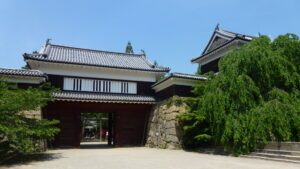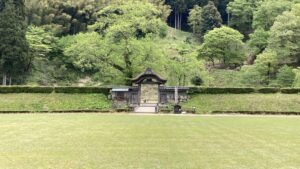Sanada Maru: Nobushige's Final Battle Against Tokugawa Ieyasu
The Sanada Red Armor represents the elite corps led by Sanada Nobushige, better known as Sanada Yukimura. Their armor, banners, and weapons were uniformly dyed in vivid shades of red or vermilion, symbolizing bold warriors. During the Siege of Osaka (1614-1615), Nobushige's forces repeatedly outmaneuvered the Tokugawa army, culminating in a daring charge into Ieyasu's headquarters and even toppled his command banner. Through these deeds, Sanada Nobushige secured his place in history as Japan's greatest warrior.
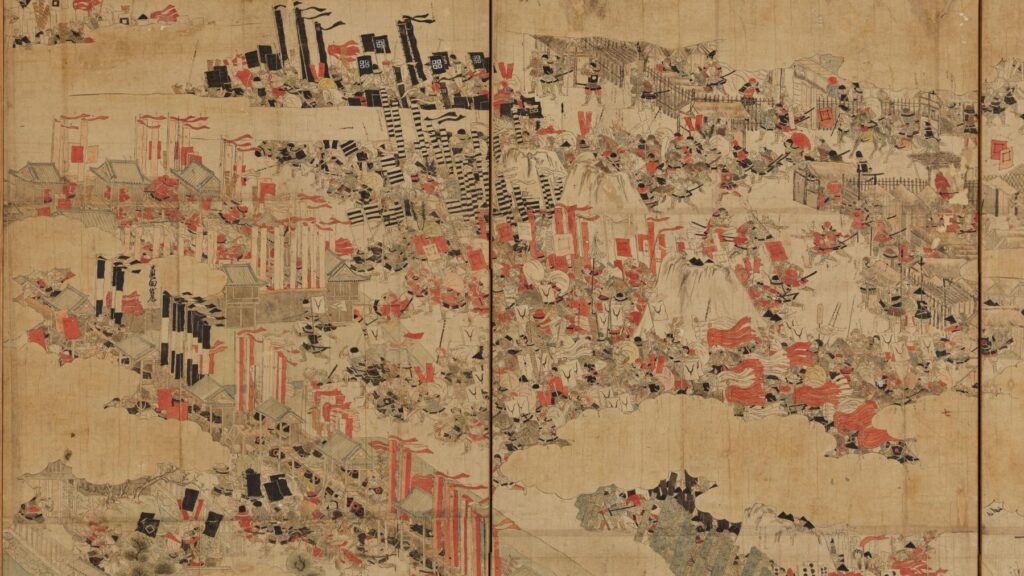
Nobushige Secures the Sanada's Survival as a Hostage
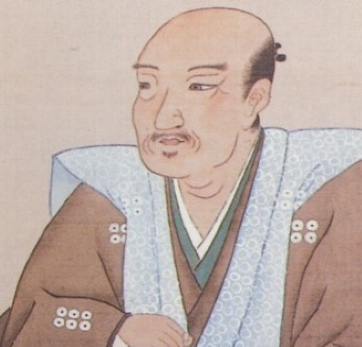
@ Ueda City Museum
Sanada Nobushige (1567-1615, 真田信繁) was the second son of Sanada Masayuki (1547-1611, 真田昌幸), a renowned genius military strategist. Together, they twice repelled the armies of Tokugawa Ieyasu (1543-1616, 徳川家康) and his son, Hidetada, during the Battle of Ueda Castle. Today, Ueda Castle, the Sanada family's stronghold, continues to captivate visitors as a living testament to their valor and tactical genius.
In 1582, the Takeda clan, which Masayuki served, was defeated during Oda Nobunaga's invasion of Koshu. Having lost his lord, Masayuki displayed remarkable intelligence and strategy in navigating the turbulent power struggles for survival among the powerful lords around Sanada territory. Shortly after pledging allegiance to the Oda clan, the sudden Honnoji Incident occurred, resulting in the death of Oda Nobunaga (1534-1582, 織田信長). With swift political acumen, Masayuki changed his allegiance, safeguarding the Sanada clan and its lands through a series of strategic maneuvers. Following his father's strategy, Nobushige was sent as a hostage in 1585, first to Uesugi Kagekatsu of Echigo to gain backing, and several months later to Toyotomi Hideyoshi (1537-1598, 豊臣秀吉), Japan's emerging ruler and Kagekatsu's overlord, to strengthen ties with the Toyotomi regime. In time, Nobushige married the daughter of Otani Yoshitsugu, one of Hideyoshi's most trusted generals. This marriage elevated Nobushige's position among the Toyotomi clan's advisors and firmly established his role as a Toyotomi retainer.
Life in Exile at Kudoyama
In 1600, the Battle of Sekigahara, known as the decisive battle for national supremacy, ended in a single day with the Tokugawa's victory. Masayuki and Nobushige, who had fought on the side of the Toyotomi, were spared execution but ordered into exile on Mount Koya. Before long, they were moved to Kudoyama, a small village at the mountain's base. Masayuki, the brilliant military strategist once praised as Takeda Shingen's two eyes, passed away in 1611, never having received a pardon for his alleged crimes. During his life in Kudoyama, Nobushige led a quiet family life, fathering several children, including his eldest and second sons, as well as daughters. However, the long years of confinement seem to have drained him of vitality. In his letters, he lamented, "I have become a great invalid..." and "My teeth have fallen out, and my beard holds little black." His words reveal a deep sense of resignation that grew day by day with each passing year.
Participation in the Siege of Osaka
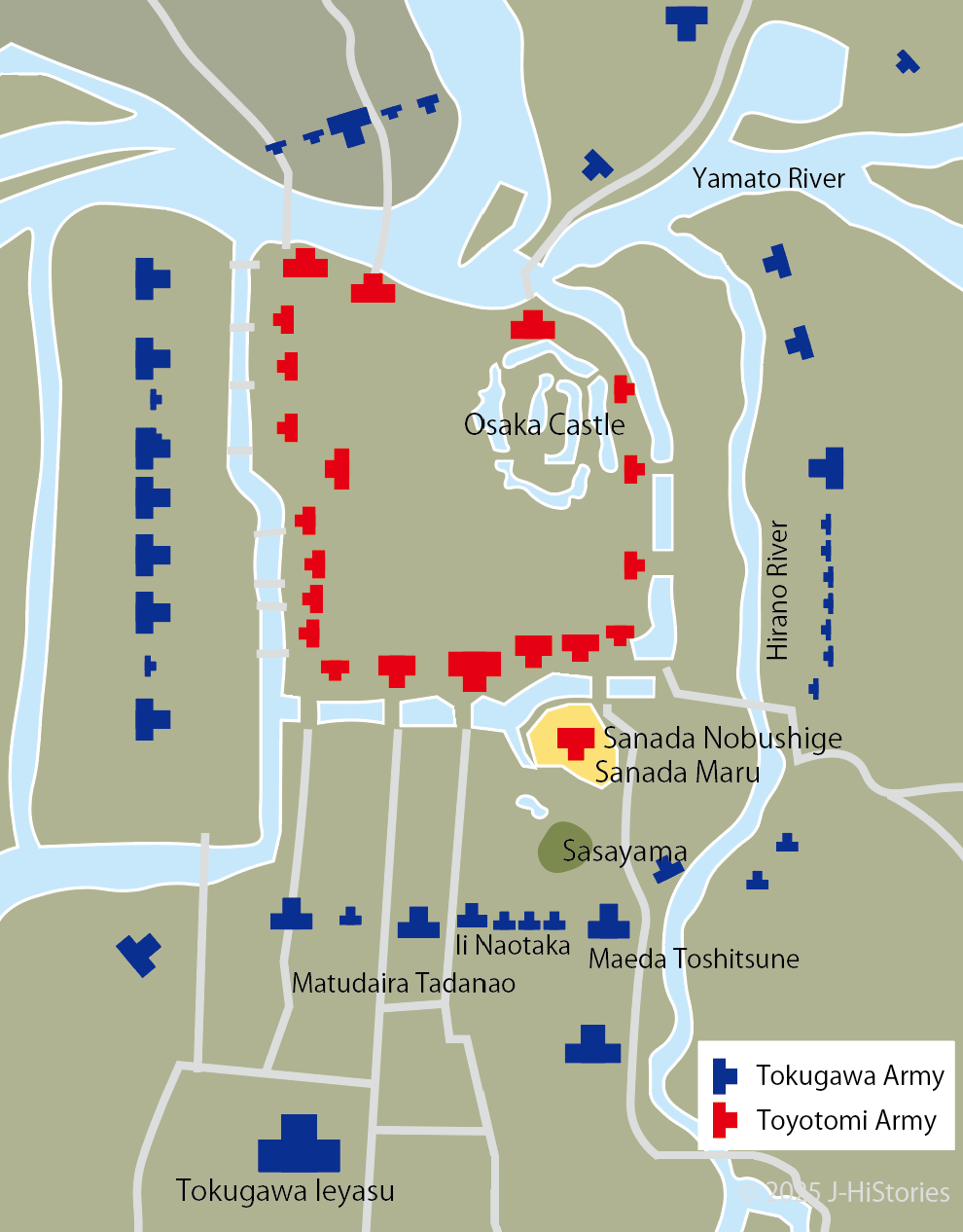
Tensions between Tokugawa Ieyasu and Toyotomi Hideyori, Toyotomi Hideyoshi’s son, steadily increased. Anticipating open conflict, Hideyori gathered ronin (masterless samurai) from across the country, stockpiled provisions and weapons, and fortified Osaka Castle for war. To secure Nobushige's support, he sent an envoy bearing 200 pieces of gold and 30 kan of silver as a war stipend. Escaping from Kudoyama, Nobushige joined the Toyotomi side and took command at the front lines. Now 49 years old, he employed the strategic brilliance inherited from his father. Recognizing a weakness in the southeastern approach to Osaka Castle -surrounded by the Yamato River, Hirano River, and defensive moats - he constructed a massive fortress known as Sanada Maru. Nobushige reinforced it with karabori (dry moats), wooden parisades, and seiro (watchtowers) equipped for fire muskets and arrows. Entering Sanada Maru with approximately 6,000 troops, he faced overwhelming enemies. Opposing him stood Maeda Toshitsune (aged 21, 1584-1568, 前田利常), commanding 12,000 men, the largest force of the Tokugawa army. Toshitsune was the fourth son of Maeda Toshiie (1538-1599, 前田利家), one of the Gotairo (Five Elders) of the Toyotomi clan. Nearby, Ii Naotaka (aged 25), the eldest son of the famed Ii Naomasa (1561-1602, 井伊直政), one of the Tokugawa Shitennō (the four great generals), led 4,000 troops, while Matsudaira Tadanori (aged 19), Ieyasu's grandson, commanded 10,000.
The Great Victory at Sanada Maru
On November 19, 1614, the Osaka Winter Campaign began with the first clash at Kizugawa-guchi. Two weeks later, on December 3, fierce fighting erupted at Sanada Maru. Before the Maeda forces tried to attack the Sasayama outpost, Nobushige strategically withdrew his troops. When the Maeda forces attacked the empty Sasayama, Nobushige mocked them with taunting words:
"Sasayama has only a few pheasants and rabbits. If you're looking for a real fight, why not try attacking Sanada Maru?"
Provoked the Maeda forces to charge toward the Sanada Maru. But Nobushige had already laid troops. As the attackers advanced, his men made a devastating barrage of gunfire and arrows, mowing enemies down one after another, and falling them into the dry moat. suffered a crushing defeat. The Tokugawa side was thrown into disarray, while the Toyotomi forces under Nobushige's brilliant command celebrated a great victory.
Peace Agreement
Although the Toyotomi forces had triumphed under Nobushige's command on the defense of Sanada Maru, it was obvious that the Toyotomi side would soon suffer from shortages of supplies and weapons, surrounded by the Tokugawa army's 200,000 troops. The Tokugawa forces continued their relentless bombardment, firing culverin cannons day and night. Several cannonballs struck the Osaka Castle keep directly, shaking morale within the Toyotomi side, and the peace agreement was broken. However, the following year, in 1615, the Summer Campaign began. The castle moats were filled in, the Sanada Maru was destroyed, leaving only the main keep exposed. For Nobushige, there remained but one strategy: to take the head of Tokugawa Ieyasu himself.
The Symbol of Strength and Elite Forces: Sanada's Red Armor
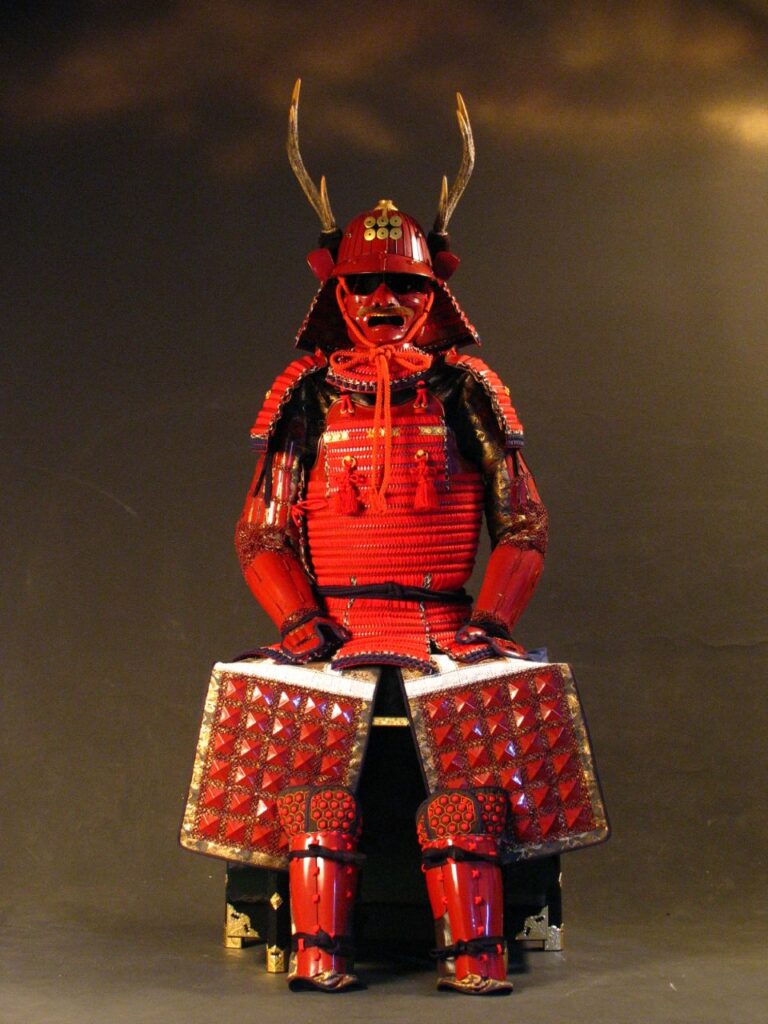
@ Ueda City Museum
On May 7, 1615, Nobushige rode to his final battle at the head of 3,000 elite warriors wearing red armor and helmets. Nobushige sat astride a horse adorned with scarlet braid, with the saddle designed by the Sanada family crest of rokumonsen (six coins). He stood on the battlefield, a truly imposing figure. Near Tennoji, within striking distance of Ieyasu's headquarters, Nobushige raised his war cry:
"The time has come! Our target is Ieyasu's head, and his head alone!"
With that, he led his troops in a furious charge against the Tokugawa lines. They broke through Matsudaira Tadanori's troops, the unit assigned to guard Ieyasu himself, and advanced so close to the main camp. Tokugawa's umajirushi (commander's flag) and banners were cut down. It is said that Ieyasu prepared himself for death, believing his end had come. After three fierce assaults, the Sanada troops, wounded and utterly exhausted, withdrew from the battlefield. Seeking refuge within the grounds of Awa Shrine, Nobushige was struck down by Tadanori's soldiers. Nobushige was at the age of 49.
The Legendary Nobushige
Nobushige, who inherited his father Masayuki's secret strategies for defeating Tokugawa Ieyasu, poured the entirety of his strength and wisdom into the six months of the Siege of Osaka. His valor, intelligence, and unwavering spirit left a mark on history. Remembered as Japan's greatest warrior, Nobushige's legend continues to move people more than four centuries later.
Sanada Nobushige's Timeline
| Sanada Masayuki | ||
| 1567 | Sanada Nobushige was born | 1 |
| 1582 | Takeda can ended | 16 |
| Sanada Masayuki served under Oda Nobunaga | 16 | |
| Nobunaga was killed at Honnoji by Akechi Mitsuhide | ||
| Sanada Masayuki served under Hōjō clan and then Tokugawa Ieyasu | ||
| 1584 | Sanada Masayuki served under Uesugi Kagekatsu | 18 |
| 1585 | The 1st Battle of Ueda Castle | 19 |
| Sanada Masayuki served under Uesugi Kagekatsu | 19 | |
| Sanada Nobushige moved to Echigo as Uesugi's hostage | ||
| Sanada Masayuki served under Toyotomi Hideyoshi | ||
| Sanada Nobushige entered Osaka Castle as Hideyoshi's hostage | ||
| 1590 | Sanada Nobushige’s first battle at the Siege of Odawara Castle | 24 |
| 1594 | Sanada Nobushige married a daugther of Otani Yoshitsugu | 28 |
| 1600 | The 2nd Battle of Ueda Castle | 34 |
| The Battle of Sekigahara | ||
| Sanada Nobushige and Masayuki were exiled to Kōyasan and Kudoyama | ||
| 1603 | Ieyasu established the Tokugawa Shogunate at Edo | 37 |
| 1611 | Sanada Masayuki died | 45 |
| 1614 | The Winter Siege of Osaka | 48 |
| 1615 | The Summer Siege of Osaka | 49 |
| Sanada Nobushige died |
Recommendations to Visit
Osaka Castle Museum and Park
- Access: 10 minutes from JR Osaka Station on JR Osaka Loop Line (outbound) to Osakajo-koen Station (大阪城公園), then an 18-minute walk.
Kudoyama Sanada Museum
- Access: 65 minutes from Nanba Station on the Nankai Koya Line to Kudoyama Station (九度山), then a 10-minute walk.

